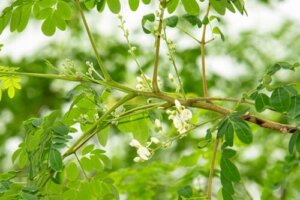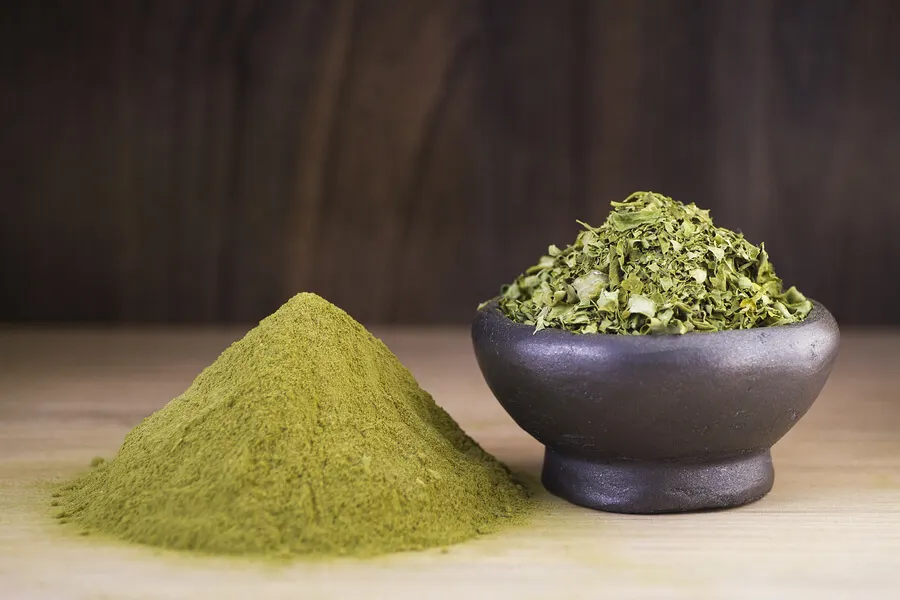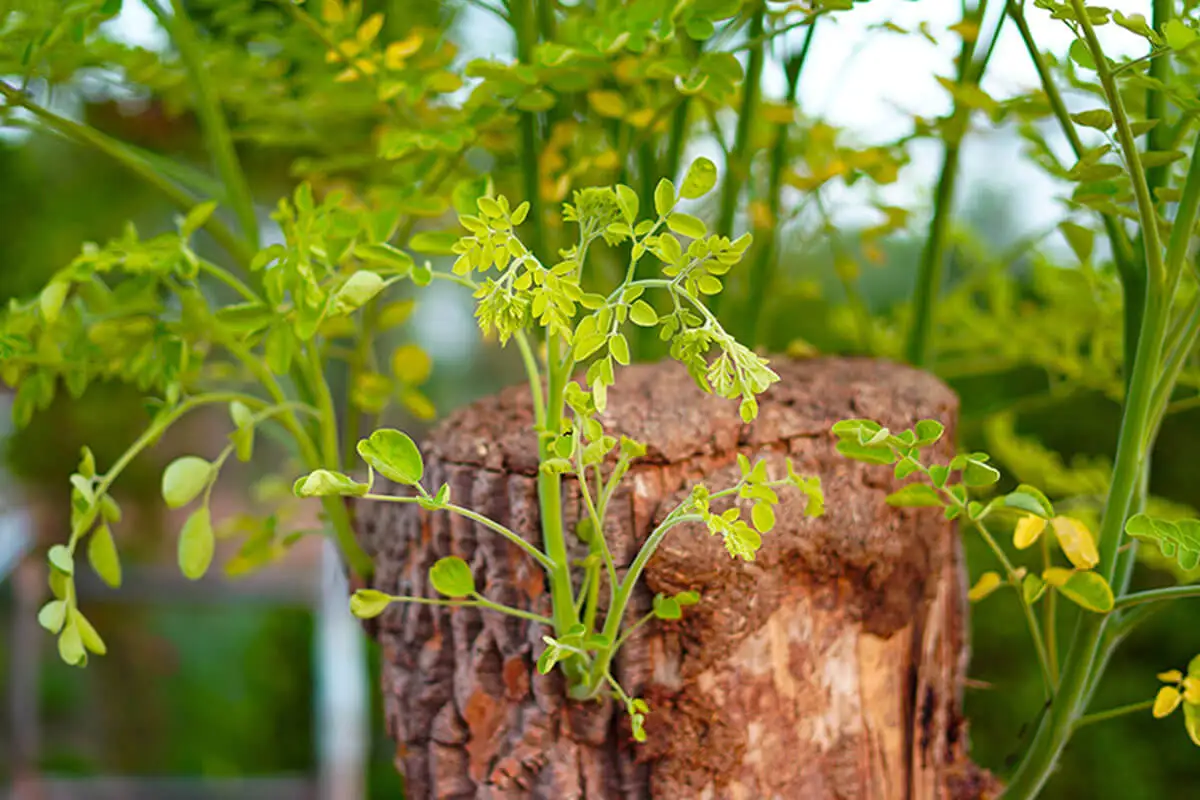A Complete Guide to Planting Moringa at Home


Reviewed and approved by the doctor Leonardo Biolatto
Most of us have heard about the properties of moringa leaves. However, did you know that this tree is ideal for planting at home? In this article, we’re going to tell you a little about this species, and, in addition, we’re going to delve into its benefits and teach you how to have your own!
Although this is a species native to India, it adapts very well to different types of soil and temperatures, so you can surely grow it and have it in your home.
Moringa: What is it?
As we already mentioned, moringa is a tree that’s also known as the tree of life. It can reach up to 10 meters in height and a considerable leafiness. It has gained worldwide fame for its nutritional properties.
Its leaves are the most used in different preparations. In fact, they are widely used in traditional Indian medicine or Ayurveda. The natural conditions in which the species grows are characterized by being warm and humid at the same time.
Its areas of greatest distribution are America, Africa, Europe, and Asia.
In addition to the leaves, its properties are also found in the roots, fruits, and seeds. According to some articles, moringa provides 27% protein, as well as vitamins A and C, and minerals such as iron, phosphorus, and calcium.

Its benefits
Due to its composition, moringa is a natural product that is recommended, in the areas of naturopathic medicine, to complement the treatment of different health conditions. According to some scientific publications, it could be useful for the following:
- Decrease inflammation.
- Improve stomach disorders, such as gastritis.
- Reduce pain, thanks to its analgesic properties.
- Protect the liver and prevent hepatorenal dysfunctions.
- Increase the rate of skin healing. Although the evidence is proven in animals and not in humans.
Like this article? We think you may also like to read: Do Moringa Seeds Help to Lose Weight?
Planting moringa at home: A step-by-step guide
Planting moringa at home is a very good idea, as this is a beautiful tree you can use to prepare infusions. Thus, you may benefit from its nutritional properties.
Its cultivation can be done in three ways:
- Germinating its seeds.
- Sowing cuttings.
- Starting from the plant in a more developed stage.
Here we tell you how to do it, according to these methods!

1. Germination of seeds
The first way to sow moringa at home is through the germination of its seeds. These can be acquired in nurseries or specialized stores, without major problems.
Once you have them, then do the following:
- Place them in a container with water for 24 hours to soften the shell.
- Then, prepare the pot in which you are going to sow the moringa or select the piece of garden in which you will put the seeds.
- Make a hole 5 centimeters deep and moisten the substrate.
- Place the seeds in there, cover them, and water them again.
- During the first 10 days, you will need to water almost daily. The key is to keep the soil moist, but not waterlogged.
- After a week you will be able to see the sprouts and after a week you will see an tiny growing tree.
- Then, keep in mind that if you are going to sow several moringa seeds, you should leave 30 to 40 centimeters between each one.
- However, if you have chosen a pot for your moringa, it should be at least 30 centimeters deep.
2. Planting moringa cuttings
The second option we have for planting moringa includes its cuttings. Furthermore, you can get them from a friend or relative who already has a tree.
You should do the following:
- Identify a branch that is 30 centimeters long and about 4 centimeters in diameter on the main trunk.
- Cut it off and plant it in the pot or in the garden, whichever you have arranged.
- Regardless of where you put it, you must ensure a 15-centimeter deep hole in the soil to place the cutting there.
- Then, in a few days, like love and watering, the roots of your cutting will grow and give firmness to your moringa tree.
3. Planting a small moringa tree
We’re going to conclude this guide to planting a moringa tree at home with the last option. When we talk about a small tree, we mean one that you bought at a nursery. You can place it in a pot or directly in the garden.
They usually come with soil and roots, so all you have to do is make a deep and sufficient hole to cut the plastic and put the plant with all the soil it already comes with. It may need a little more substrate to make it firm.
Water it, and that’s it. Soon you will see how your plant begins to grow in the space you have set aside for it.
We think you may also like to read this article: The Characteristics of Moringa Oil and Its Uses
Take care of your moringa to make it a source of life!
As the tree of life that it is, moringa needs some extra care that you must provide for it to grow healthy. Take note of the most important ones!
- This tree needs direct light.
- Moringa trees require light, sandy soil with good drainage.
- The ideal temperature for this tree is between 22 and 35 degrees Celsius; it should always be below 40 °C.
- You should do an annual pruning to shape it, control growth, and remove any dry branches.
- Moderate your watering so the substrate is always humid, but not waterlogged.
That’s it! You now know everything you need to plant your moringa at home and enjoy its benefits.
All cited sources were thoroughly reviewed by our team to ensure their quality, reliability, currency, and validity. The bibliography of this article was considered reliable and of academic or scientific accuracy.
- Fahey, J. W. (2005). Moringa oleifera. A review of the medical evidence for its nutritional, therapeutic and prophylactic properties. Trees for Life Journal, 1(5), 1-15.
- Fuentes Esparza, M; Quezada, T; Guzmán, S; Valdivia-Flores, A; Ortíz-Martínez, R. (2019). Efecto del consumo de Moringa oleífera sobre parámetros productivos y toxicológicos en pollos de engorde. Rev Mex Cienc Pecu. 10(4):1013-1026.
- González Valenzuela, C. M., & Romero Mayorga, A. E. (2017). Comparación de actividad cicatrizante entre los aceites de las semillas de azadirachta indica y moringa oleífera en heridas cutáneas en ratas wistar (Doctoral dissertation, Universidad de Guayaquil. Facultad de Ciencias Químicas).
- Kumbhare, M., & Sivakumar, T. (2011). Anti-inflammatory and analgesic activity of stem bark of Moringa oleifera. Pharmacologyonline, 3, 641-650.
- Martínez-González, C. L., Martínez, L., Martínez-Ortiz, E. J., González-Trujano, M. E., Déciga-Campos, M., Ventura-Martínez, R., & Díaz-Reval, I. (2017). Moringa oleifera, a species with potential analgesic and anti-inflammatory activities. Biomedicine & Pharmacotherapy, 87, 482-488.
- Soliman, M. M., Aldhahrani, A., Alkhedaide, A., Nassan, M. A., Althobaiti, F., & Mohamed, W. A. (2020). The ameliorative impacts of Moringa oleifera leaf extract against oxidative stress and methotrexate-induced hepato-renal dysfunction. Biomedicine & Pharmacotherapy, 128, 110259.
- Villarreal Gómez, A; Ortega Angulo, K. (2014). Revisión de las características y usos de la planta moringa oleífera. Investigación & desarrollo vol 22, n° 2. págs. 309-330. issn 2011-7574 (on line).
This text is provided for informational purposes only and does not replace consultation with a professional. If in doubt, consult your specialist.








